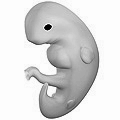- The term trimester redirects here. For the term trimester used in academic settings, see Academic term
Pregnancy is typically broken into three periods, or trimesters, each of about three months. While there are no hard and fast rules, these distinctions are useful in describing the changes that take place over time.
First trimester

Traditionally, doctors have measured pregnancy from a number of convenient points, including the day of last menstruation, ovulation, fertilization, implantation and chemical detection. In medicine, pregnancy is often defined as beginning when the developing embryo becomes implanted into the endometrial lining of a woman's uterus. In some cases where complications may have arisen, the fertilized egg might implant itself in the fallopian tubes or the cervix, causing an ectopic pregnancy. Most pregnant women do not have any specific signs or symptoms of implantation, although it is not uncommon to experience light bleeding at implantation. Some women will also experience cramping during their first trimester. This is usually of no concern unless there is spotting or bleeding as well. The outer layers of the embryo grow and form a placenta, for the purpose of receiving essential nutrients through the uterine wall, or endometrium. The umbilical cord in a newborn child consists of the remnants of the connection to the placenta. The developing embryo undergoes tremendous growth and changes during the process of foetal development.
Morning sickness can occur in about seventy percent of all pregnant women and typically improves after the first trimester. Most miscarriages occur during this period.

Second trimester
Months 4 through 6 of the pregnancy are called the second trimester. Most women feel more energized in this period, and begin to put on weight as the symptoms of morning sickness subside and eventually fade away. Although the fetus begins moving and takes a recognizable human shape during the first trimester, it is not until the second trimester that movement of the fetus, often referred to as "quickening", can be felt. This typically happens by the fourth month. The placenta is now fully functioning and the fetus is making insulin and urinating. The teeth are now formed inside the fetus's gums and the reproductive organs can be recognized, and can distinguish the fetus as male or female.
Third trimester
Final weight gain takes place, and the fetus begins to move regularly. The woman's navel will sometimes become convex, "popping" out, due to her expanding abdomen. This period of her pregnancy can be uncomfortable, causing symptoms like weak bladder control and back-ache. Movement of the fetus becomes stronger and more frequent and via improved brain, eye, and muscle function the fetus is prepared for ex utero viability. The woman can feel the fetus "rolling" and it may cause pain or discomfort when it is near the woman's ribs.
It is during this time that a baby born prematurely may survive. The use of modern medical intensive care technology has greatly increased the probability of premature babies living, and has pushed back the boundary of viability to much earlier dates than would be possible without assistance.[20] In spite of these developments, premature birth remains a major threat to the fetus, and may result in ill-health in later life, even if the baby survives.
Prenatal development and sonograph images
- See also: Prenatal development.
Prenatal development is divided into two primary biological stages. The first is the embryonic stage, which lasts for about two months. At this point, the fetal stage begins. At the beginning of the foetal stage, the risk of miscarriage decreases sharply,[21] all major structures including hands, feet, head, brain, and other organs are present, and they continue to grow and develop. When the fetal stage commences, a fetus is typically about 30 mm (1.2 inches) in length, and the heart can be seen beating via sonograph; the fetus bends the head, and also makes general movements and startles that involve the whole body. Brain stem activity has been detected as early as 54 days after conception,[23] and the first measurable signs of EEG activity occur in the 12th week. Some fingerprint formation occurs from the beginning of the fetal stage
 Embryo at 6 weeks after fertilization |  Fetus at 8 weeks after fertilization |  Fetus at 18 weeks after fertilization |  Fetus at 38 weeks after fertilization |
 Relative size in 1st Month (simplified illustration) |  Relative size in 3rd Month (simplified illustration) |  Relative size in 5th Month (simplified illustration) |  Relative size in 9th Month (simplified illustration) |
One way to observe prenatal development is via ultrasound images. Modern 3D ultrasound images provide greater detail for prenatal diagnosis than the older 2D ultrasound technology.[30] Whilst 3D is popular with parents desiring a prenatal photograph as a keepsake,[31] both 2D and 3D are discouraged by the FDA for non-medical use,[32] but there are no definitive studies linking ultrasound to any adverse medical effects.[33] The following 3D ultrasound images were taken at different stages of pregnancy:
 3-inch fetus (about 14 weeks gestational age) |  Fetus at 17 weeks |  Fetus at 20 weeks |
Management
Prenatal medical care is of recognized value throughout the developed world. Periconceptional Folic acid supplementation is the only type of supplementation of proven efficacy.
Nutrition
A balanced, nutritious diet is an important aspect of a healthy pregnancy. If the woman is healthy, balancing carbohydrates, fat, and proteins, and eating a variety of fruits and vegetables usually ensure good nutrition. Those whose diets are affected by health issues, religious requirements, or ethical beliefs may choose to consult a health professional for specific advice.
Adequate periconceptional Folic acid (also called folate or Vitamin B9) intake has been proven to limit fetal neural tube defects, preventing spina bifida, a very serious birth defect. The neural tube develops during the first 28 days of pregnancy and this explains the necessity to guarantee adequate periconceptional folate intake.[34][35] Folates (from folia, leaf) are abundant in spinach (fresh, frozen or canned), and are also found in green vegetables, salads, melon, hummus, and eggs. In the United States and Canada, most wheat products (flour, noodles) are fortified with folic acid.
Several micronutrients are important for the health of the developing fetus, especially in areas of the world where insufficient nutrition is prevalent. In developed areas, such as Western Europe and the United States, certain nutrients such as Vitamin D and calcium, required for bone development, may require supplementation.
There is some evidence that long-chain omega-3 (n-3) fatty acids have an effect on the developing fetus, but further research is required. At this time, supplementing the diet with foods rich in these fatty acids is not recommended, but is not harmful.
Dangerous bacteria or parasites may contaminate foods, particularly listeria and toxoplasma, toxoplasmosis agent. Careful washing of fruits and raw vegetables may remove these pathogens, as may thoroughly cooking leftovers, meat, or processed meat. Soft cheeses may contain listeria, if milk is raw the risk may increase. Cat feces pose a particular risk of toxoplasmosis. Pregnant women are also more prone to catching salmonella infection from eggs and poultry, which should be thoroughly cooked. Practicing good hygiene in the kitchen can reduce these risks.
Weight gain
Caloric intake must be increased, to ensure proper development of the fetus. The amount of weight gained during pregnancy varies between women. The National Health Service recommends that overall weight gain during the 9 month period for women who start pregnancy with normal weight be 10 to 12 kilograms (22–26 lb).[44] During pregnancy, insufficient weight gain can compromise the health of the fetus. Women with fears of weight gain or with eating disorders may choose to work with a health professional, to ensure that pregnancy does not trigger disordered eating. Likewise, excessive weight gain can pose risks to the woman and the fetus. Women who are prone to being overweight may choose to plan a healthy diet and exercise plan to help moderate the amount of weight gained.


No comments:
Post a Comment